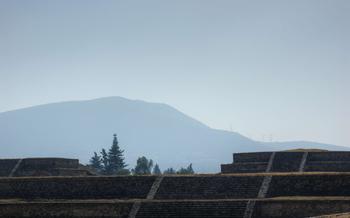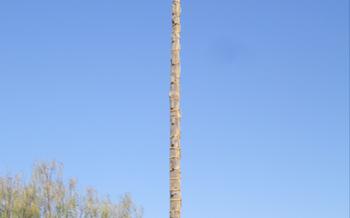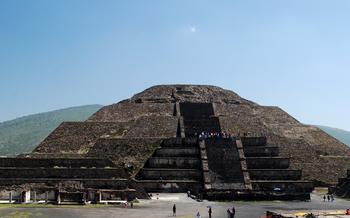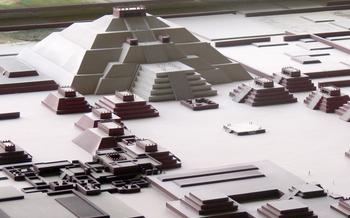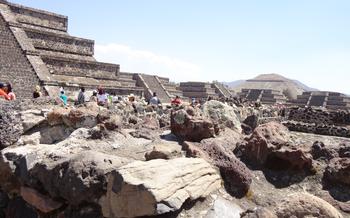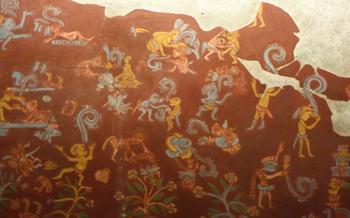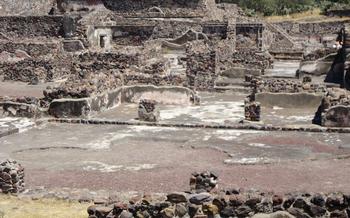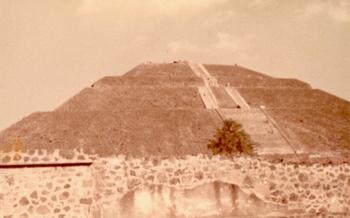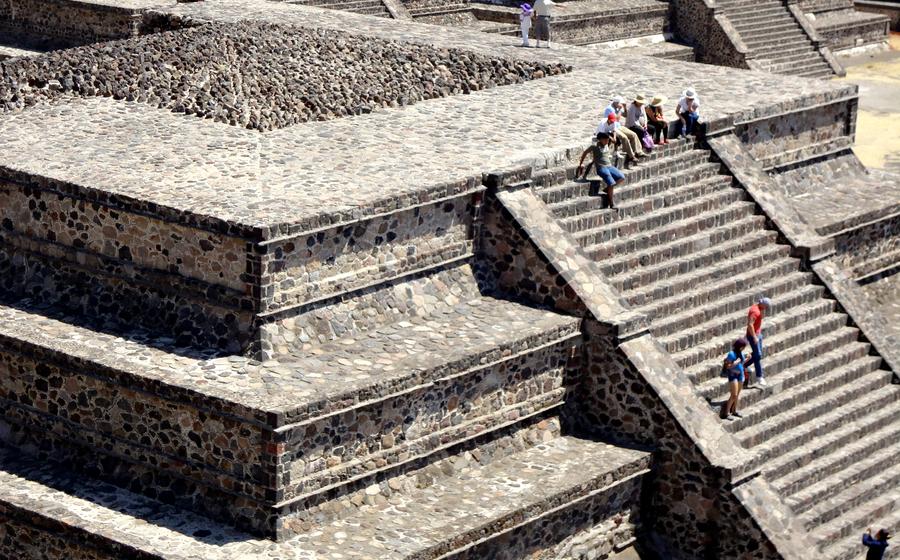
Arena México
- Historical Significance:
- Sun Pyramid (Pirámide del Sol):
- Moon Pyramid (Pirámide de la Luna):
- Avenue of the Dead
- Temple of Quetzalcoatl:
- Museum of Teotihuacan Culture:
- Teotihuacan's Role in Mesoamerican Culture
- Theories of Teotihuacan's Fall
- How to Get to Teotihuacan:
- Best Time to Visit
- What to Wear and Bring
- Guided Tours
- Accessibility
- Photography Tips
- Insider Tip: The Teotihuacan Tunnels
Historical Significance:
Teotihuacan, an ancient city in Mexico, holds immense historical significance as a prominent religious and political center in Mesoamerica. Its origins remain shrouded in mystery, with various theories speculating on its construction and ultimate abandonment. Archaeological discoveries have unveiled a rich tapestry of cultural practices, beliefs, and architectural wonders, providing glimpses into the lives of its inhabitants. Teotihuacan's legacy continues to captivate historians, archaeologists, and visitors alike, inviting them to delve into the enigmas of this once-thriving metropolis.
Sun Pyramid (Pirámide del Sol):
The Sun Pyramid, also known as the Pyramid of the Sun, stands as a testament to the architectural prowess of the Teotihuacan civilization. As the largest structure in the city, it dominates the skyline and draws visitors from around the world. With a height of approximately 213 feet (65 meters) and a base measuring 761 feet (232 meters) on each side, the Sun Pyramid is a sight to behold.
The pyramid's construction is shrouded in mystery, as the ancient builders left no written records behind. Archaeologists believe that it was constructed over several decades, using a combination of mud bricks and stone. The pyramid's alignment with the sun during the spring and autumn equinoxes suggests that it had astronomical significance, possibly serving as a calendar or a ceremonial center for religious rituals.
Exploring the Sun Pyramid is a unique experience that allows visitors to marvel at its sheer size and intricate construction. Climbing the steep steps to the top of the pyramid rewards visitors with breathtaking views of the surrounding landscape, including the Avenue of the Dead and the Moon Pyramid. While the climb can be challenging, it is well worth the effort for the stunning panoramas that await at the summit.
Moon Pyramid (Pirámide de la Luna):
The Moon Pyramid (Pirámide de la Luna) is the second-largest structure in Teotihuacan, standing at an impressive height of 45 meters. While smaller than the Sun Pyramid, the Moon Pyramid holds its own significance and unique features.
Compared to the Sun Pyramid, the Moon Pyramid has a steeper incline and a more compact design. Its alignment with the moon's cycles and its use for religious rituals set it apart from its larger counterpart. Archaeological excavations have revealed complex interior chambers within the pyramid, hinting at its sacred and ceremonial purpose.
The Moon Pyramid's symbolism is closely tied to the lunar deity, who played an important role in Teotihuacan mythology. The pyramid's alignment with the moon's phases and its position at the end of the Avenue of the Dead suggest its connection to lunar cycles and fertility rituals.
Recent excavations have uncovered several underground chambers within the Moon Pyramid, shedding light on its complex interior. These chambers contain elaborate murals and artifacts, providing valuable insights into the religious beliefs and practices of the Teotihuacan people.
Visitors to Teotihuacan can climb the Moon Pyramid for a breathtaking view of the surrounding landscape. The pyramid's smaller size and less crowded nature make it a more intimate and serene experience compared to the Sun Pyramid.
Avenue of the Dead
Stretching for over two miles, the Avenue of the Dead is the grand ceremonial pathway that runs through the heart of Teotihuacan. Flanked by towering platforms, temples, and residential compounds, this impressive avenue served as the stage for grand processions, religious rituals, and market activities.
Imagine the bustling scene as merchants displayed their wares, pilgrims journeyed to sacred temples, and elaborate parades honored the city's gods. The Avenue of the Dead was a vibrant artery that connected the various districts of Teotihuacan, facilitating trade, cultural exchange, and the movement of people.
Among the notable landmarks along the avenue are the Citadel, a massive complex that housed administrative and religious buildings, and the Temple of Quetzalcoatl, dedicated to the feathered serpent god. The avenue also features numerous smaller temples, platforms, and residential structures, each contributing to the city's rich tapestry of architecture and urban planning.
Walking along the Avenue of the Dead, one can't help but be awed by the sheer scale and grandeur of Teotihuacan. The towering pyramids, the intricate carvings, and the vibrant colors transport visitors back in time, allowing them to experience the majesty of this ancient metropolis.
Temple of Quetzalcoatl:
The Temple of Quetzalcoatl, dedicated to the feathered serpent god, stands as a testament to the artistic and religious prowess of Teotihuacan's civilization. Unlike the Sun and Moon Pyramids, this temple boasts a unique architectural style characterized by intricate sculptures and vibrant murals that adorn its walls.
The temple's façade is a masterpiece of artistry, featuring alternating panels of intricate stone carvings and colorful murals depicting Quetzalcoatl and other deities. The serpent heads that protrude from the temple's corners, their jaws agape as if ready to devour any trespassers, are particularly striking.
Inside the temple, visitors can explore a series of chambers and corridors adorned with more murals and sculptures. These artworks provide valuable insights into Teotihuacan's mythology and religious practices. The temple's iconography is rich in symbolism, with recurring motifs such as the feathered serpent, the rain god Tlaloc, and the jaguar, representing power and strength.
The Temple of Quetzalcoatl is not only a testament to Teotihuacan's artistic achievements but also a reminder of the city's deep spiritual beliefs. This temple offers a glimpse into the complex religious system that governed the lives of the Teotihuacanos and played a crucial role in shaping their culture and society.
Museum of Teotihuacan Culture:
Enrich your understanding of Teotihuacan's history and culture with a visit to the on-site Museum of Teotihuacan Culture. Immerse yourself in the captivating exhibits that showcase a diverse collection of artifacts, pottery, and other relics excavated from the ancient city. Discover the stories behind these precious objects and gain insights into the daily lives, beliefs, and artistic expressions of the Teotihuacan people.
The museum's well-curated displays take you on a journey through time, providing a comprehensive overview of Teotihuacan's rise, development, and eventual decline. Learn about the city's political structure, its complex religious system, and its intricate urban planning. Admire the intricate craftsmanship and symbolism of the artifacts, which range from intricately carved stone sculptures to delicate ceramic vessels.
Don't miss the museum's special exhibitions, which often focus on specific aspects of Teotihuacan culture or feature new archaeological discoveries. These exhibitions offer an opportunity to delve deeper into the city's history and gain insights from the latest research. Educational programs and guided tours are also available to enhance your museum experience and bring the ancient world of Teotihuacan to life.
Teotihuacan's Role in Mesoamerican Culture
Teotihuacan's influence extended far beyond its physical borders, leaving an indelible mark on the cultural and religious landscape of Mesoamerica. Its impact can be seen in the art, architecture, and beliefs of subsequent civilizations such as the Maya and the Aztecs.
Teotihuacan served as a major trade hub, facilitating the exchange of goods and ideas between diverse regions of Mesoamerica. Its strategic location allowed for the movement of exotic goods such as obsidian, jade, and cacao, contributing to the economic prosperity of the city and its surrounding areas.
Moreover, Teotihuacan played a pivotal role in the spread of religious beliefs and practices throughout the region. The city's impressive temples and iconography were widely imitated, and its deities, particularly Quetzalcoatl, became prominent figures in other Mesoamerican mythologies.
The influence of Teotihuacan can be observed in archaeological sites across Mesoamerica. For instance, the Maya city of Tikal features a temple known as the Temple of the Grand Jaguar, which bears striking similarities to the Temple of Quetzalcoatl in Teotihuacan. Similarly, the Aztec capital of Tenochtitlan was designed with a central avenue resembling Teotihuacan's Avenue of the Dead, reflecting the deep reverence for the ancient city's urban planning and religious traditions.
Teotihuacan's legacy continues to inspire and fascinate scholars and visitors alike. Its enduring influence on Mesoamerican culture serves as a testament to the city's profound impact on the region's history and development.
Theories of Teotihuacan's Fall
The reasons behind the decline and eventual abandonment of Teotihuacan remain shrouded in mystery, leading to various theories attempting to explain this enigmatic event. One theory suggests that environmental factors played a crucial role. Prolonged droughts or changes in climate could have caused agricultural failures and water shortages, leading to social unrest and the city's eventual decline. Another theory revolves around political conflicts and internal strife. Competition for power among different factions within Teotihuacan or conflicts with neighboring city-states could have resulted in internal divisions and weakened the city's stability.
Recent research and archaeological findings have shed new light on the possible causes of Teotihuacan's fall. Excavations have revealed evidence of widespread burning and destruction, suggesting that the city may have been sacked or invaded by an external force. This theory aligns with historical accounts from later Mesoamerican civilizations, which mention conflicts and wars between Teotihuacan and other regional powers.
Another intriguing theory proposes that Teotihuacan's demise was a result of a combination of factors. Environmental challenges, coupled with internal conflicts and external threats, may have created a perfect storm that led to the city's collapse. Understanding the reasons behind Teotihuacan's fall is crucial for gaining a deeper appreciation of the complexity and fragility of ancient civilizations.
How to Get to Teotihuacan:
From Mexico City:
- Public Transportation:
- Take the metro to the Indios Verdes station on Line 3 (green line).
- From there, catch a bus bound for Teotihuacan from the bus terminal outside the station.
- The journey takes about 1-5 hours, depending on traffic.
- Driving:
- Take the Autopista México-Querétaro toll road and follow the signs for Teotihuacan.
- The drive takes about 45-60 minutes, depending on traffic.
Cost:
- Public transportation: Approximately $5-10 USD round trip.
- Driving: Approximately $10-15 USD for tolls and parking.
Guided Tours:
- Many tour operators offer guided tours to Teotihuacan from Mexico City.
- Tours typically include transportation, a guided tour of the site, and lunch.
- Prices start from around $50 USD per person.
Tips:
- Book your tour or transportation in advance, especially if visiting during peak season.
- Arrive early to avoid crowds and the midday heat.
- Wear comfortable shoes and clothing, as you'll be doing a lot of walking.
- Bring water, sunscreen, and a hat to protect yourself from the sun.
Best Time to Visit
Deciding the perfect time to visit Teotihuacan can significantly enhance your experience. While the ancient city welcomes visitors year-round, strategic planning can help you avoid crowds, enjoy favorable weather, and make the most of your trip.
Teotihuacan experiences two distinct seasons: the dry season and the rainy season. The dry season, which runs from November to April, offers the most pleasant weather for exploring the site. During these months, the skies are mostly clear, with warm and sunny days. However, this period also coincides with the peak tourist season, so expect larger crowds.
If you prefer a quieter and more intimate experience, consider visiting during the shoulder seasons, which fall between April and May and September and October. These months offer a good balance between pleasant weather and fewer tourists, allowing you to explore the site at a more relaxed pace.
During the rainy season, from May to October, Teotihuacan receives frequent rainfall. While the rain can bring a refreshing respite from the heat, it can also make the pathways muddy and slippery. However, the lush greenery that emerges during this time can offer a unique and picturesque backdrop for your photos.
To avoid the biggest crowds, plan your visit for a weekday rather than a weekend. Arriving early in the morning is also advisable, as the site tends to get busier as the day progresses.
No matter when you choose to visit, Teotihuacan offers a remarkable journey back in time. Embrace the rich history, marvel at the architectural wonders, and let the spirit of this ancient city captivate your senses.
What to Wear and Bring
Exploring Teotihuacan requires appropriate attire and essential items to ensure a comfortable and enjoyable experience. Due to the hot and dusty conditions, lightweight, breathable clothing is recommended. Consider wearing loose-fitting, light-colored garments to stay cool under the sun. Opt for comfortable walking shoes or sandals with good traction to navigate the uneven terrain and climb the pyramids.
Sunscreen is a must-have to protect your skin from the intense UV rays. Apply sunscreen liberally and reapply throughout the day, especially if you plan to spend extended periods outdoors. A hat and sunglasses are essential to shield your head and eyes from the sun.
Hydration is crucial in the dry climate of Teotihuacan. Bring a reusable water bottle and refill it regularly at the water stations available throughout the site. Avoid sugary drinks, as they can dehydrate you more quickly.
If you plan to take photos, consider bringing a camera with a good zoom lens to capture distant details of the pyramids and murals. A tripod can also be useful for stable shots, especially in low-light conditions.
Remember, Teotihuacan is an ancient and sacred site, so dress and behave respectfully. Avoid wearing revealing clothing or making excessive noise that may disturb other visitors or detract from the site's serene atmosphere.
Guided Tours
Enhancing your visit to Teotihuacan with a guided tour is highly recommended. Experienced guides can provide valuable insights into the history, culture, and significance of the ancient city, bringing its stories to life. Various tour options are available to suit different interests and budgets.
Group tours offer a cost-effective way to explore Teotihuacan with fellow travelers. These tours typically follow a set itinerary and include commentary from a knowledgeable guide. Private tours provide a more personalized experience, allowing you to customize the itinerary based on your preferences and interests. Specialized tours focus on specific aspects of the site, such as architecture, astronomy, or mythology.
To choose the right tour, consider your interests, budget, and group size. Read reviews and recommendations online to find reputable tour operators. Booking your tour in advance is advisable, especially during peak season, to secure your spot. Guided tours often include transportation from Mexico City to Teotihuacan, making it a convenient option for visitors without their own transportation.
Accessibility
Teotihuacan is committed to providing an accessible and enjoyable experience for visitors with disabilities or mobility impairments. The archaeological site features a range of accessibility options to ensure that everyone can explore the ancient city's wonders.
Wheelchair ramps and designated accessible pathways allow visitors to navigate the site with ease. Wheelchairs are also available for rent at the main entrance, subject to availability. For visitors with visual impairments, tactile maps and audio guides are provided to enhance their understanding of the site's layout and history.
To ensure a smooth and personalized visit, it is advisable to contact the site in advance and inform them of any specific accessibility requirements. The staff is well-trained and ready to assist visitors with disabilities, providing guidance and support throughout their exploration of Teotihuacan.
Photography Tips
Capturing the grandeur and beauty of Teotihuacan through photography can be a rewarding experience. Here are some tips to help you take stunning photos:
-
Golden Hours: Visit during the early morning or late afternoon hours when the light is soft and warm, creating a magical glow that enhances the colors and textures of the ancient structures.
-
Wide-Angle Lens: Bring a wide-angle lens to capture the vastness of the pyramids and the Avenue of the Dead. This will allow you to fit more of the scene into your frame, creating dramatic and expansive compositions.
-
Tripod: Use a tripod for stable shots, especially when shooting in low-light conditions or taking long-exposure photos. This will help minimize camera shake and ensure sharp, clear images.
-
Details: Don't just focus on the big picture; take time to capture the intricate details and carvings on the pyramids and other structures. Close-up shots of the sculptures, murals, and hieroglyphs can reveal hidden stories and add depth to your photos.
-
Panoramas: Take advantage of the open spaces to create stunning panoramic shots. Stitch together a series of overlapping images using photo editing software to capture the entire expanse of the ancient city.
-
Editing: Use photo editing software to enhance your photos and bring out the best in your shots. Adjust the colors, contrast, and exposure to create a cohesive and visually appealing set of images.
Insider Tip: The Teotihuacan Tunnels
Venture beyond the main tourist areas of Teotihuacan and discover the hidden tunnels beneath the Sun Pyramid. These tunnels, known as the Túneles de Teotihuacan, offer a unique and immersive experience that allows visitors to explore the inner workings of the ancient pyramid.
To access the tunnels, look for the entrance located near the Sun Pyramid's south side. Once inside, you'll be greeted by a narrow passageway that leads deep into the pyramid's core. As you descend, be prepared for a thrilling journey through history and darkness.
The tunnels are believed to have been used by ancient priests for religious rituals and ceremonies. As you make your way through the labyrinthine passages, you'll encounter various chambers and niches that once held offerings and sacred objects. The walls are adorned with intricate carvings and paintings that provide glimpses into the beliefs and practices of Teotihuacan's inhabitants.
Exploring the tunnels is an unforgettable experience that offers a unique perspective on Teotihuacan's history and culture. However, it's important to note that the tunnels are not for the faint of heart. They are narrow, dark, and can be quite claustrophobic. Visitors should be prepared for a challenging but rewarding adventure.
